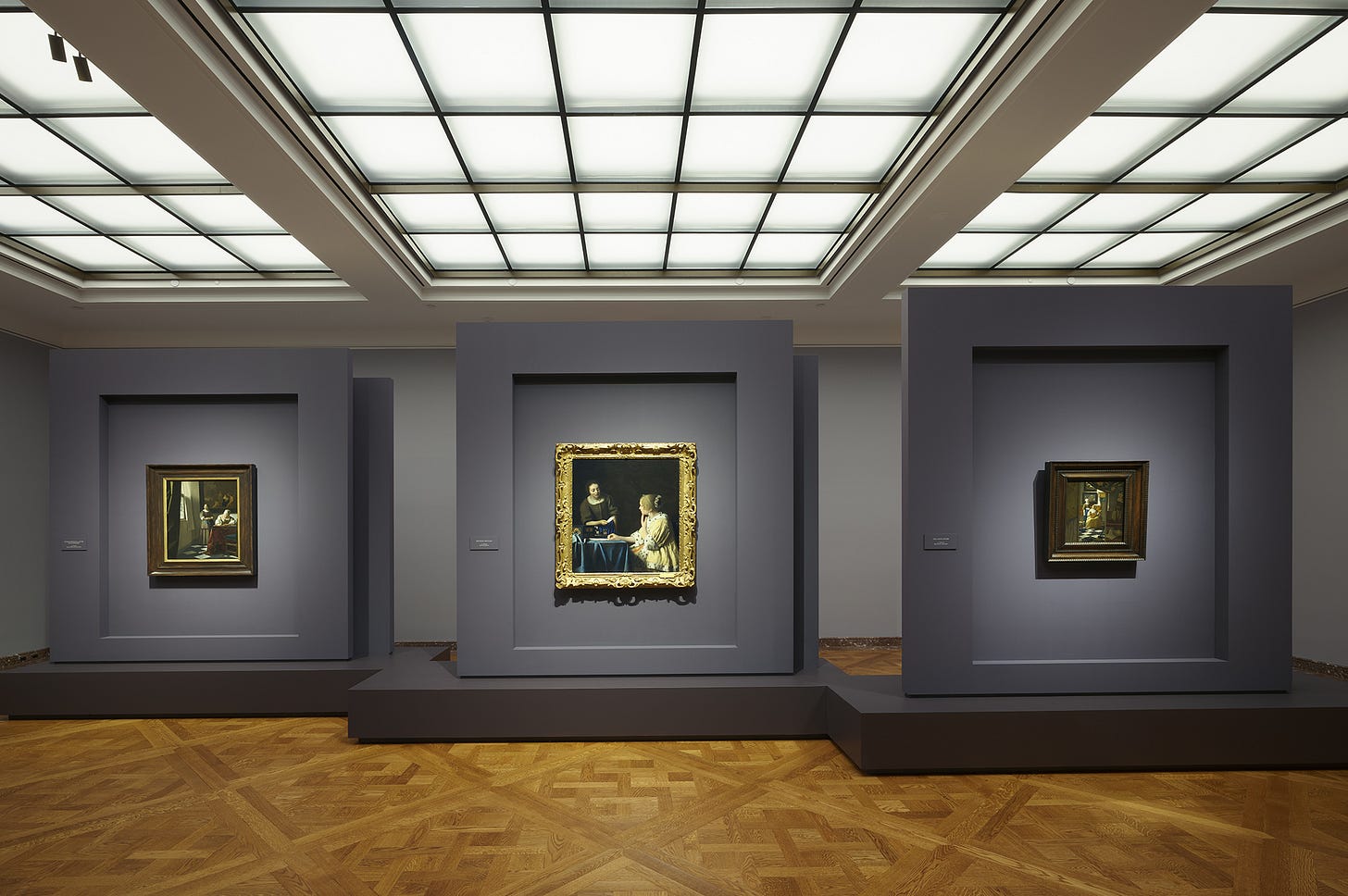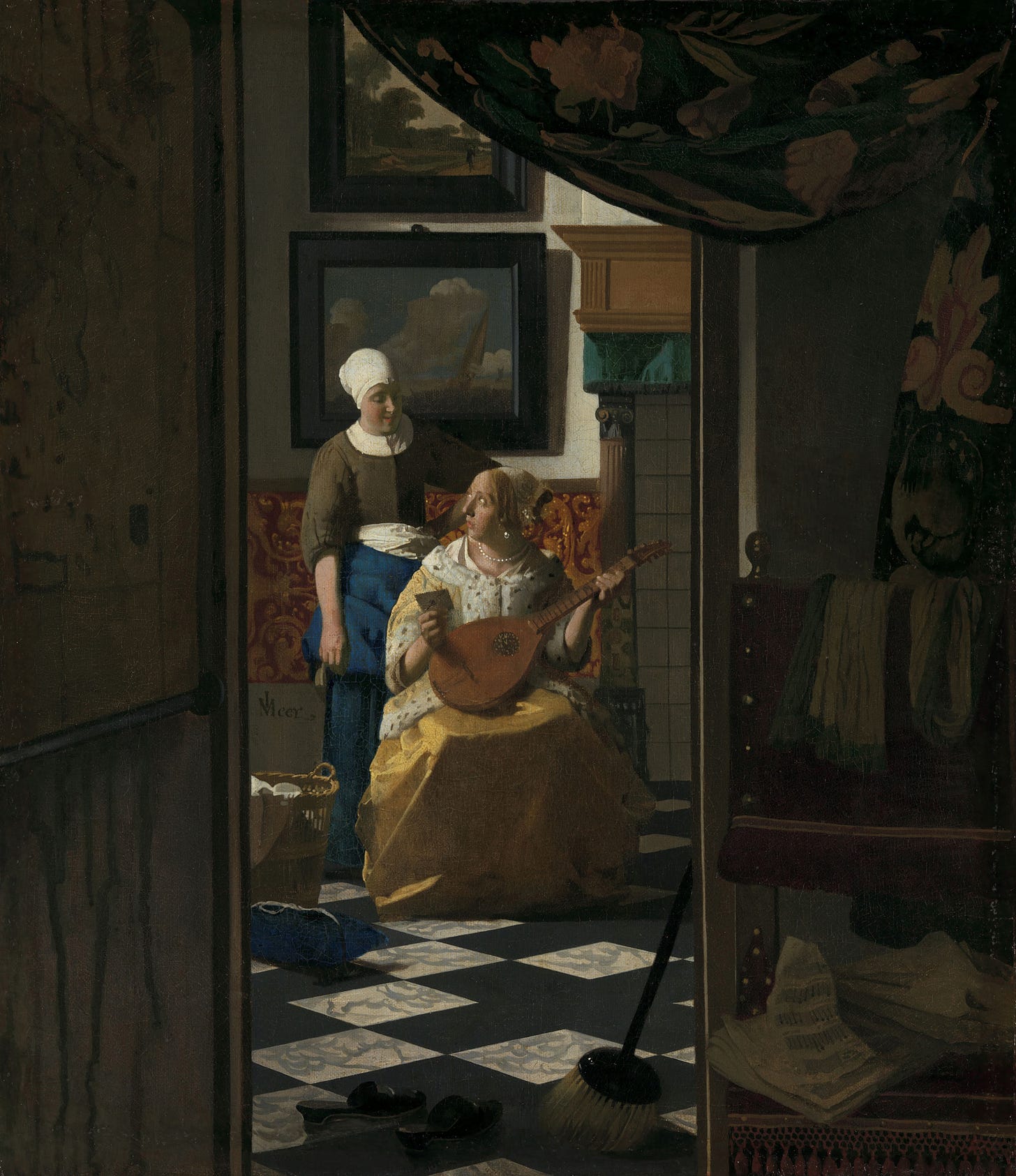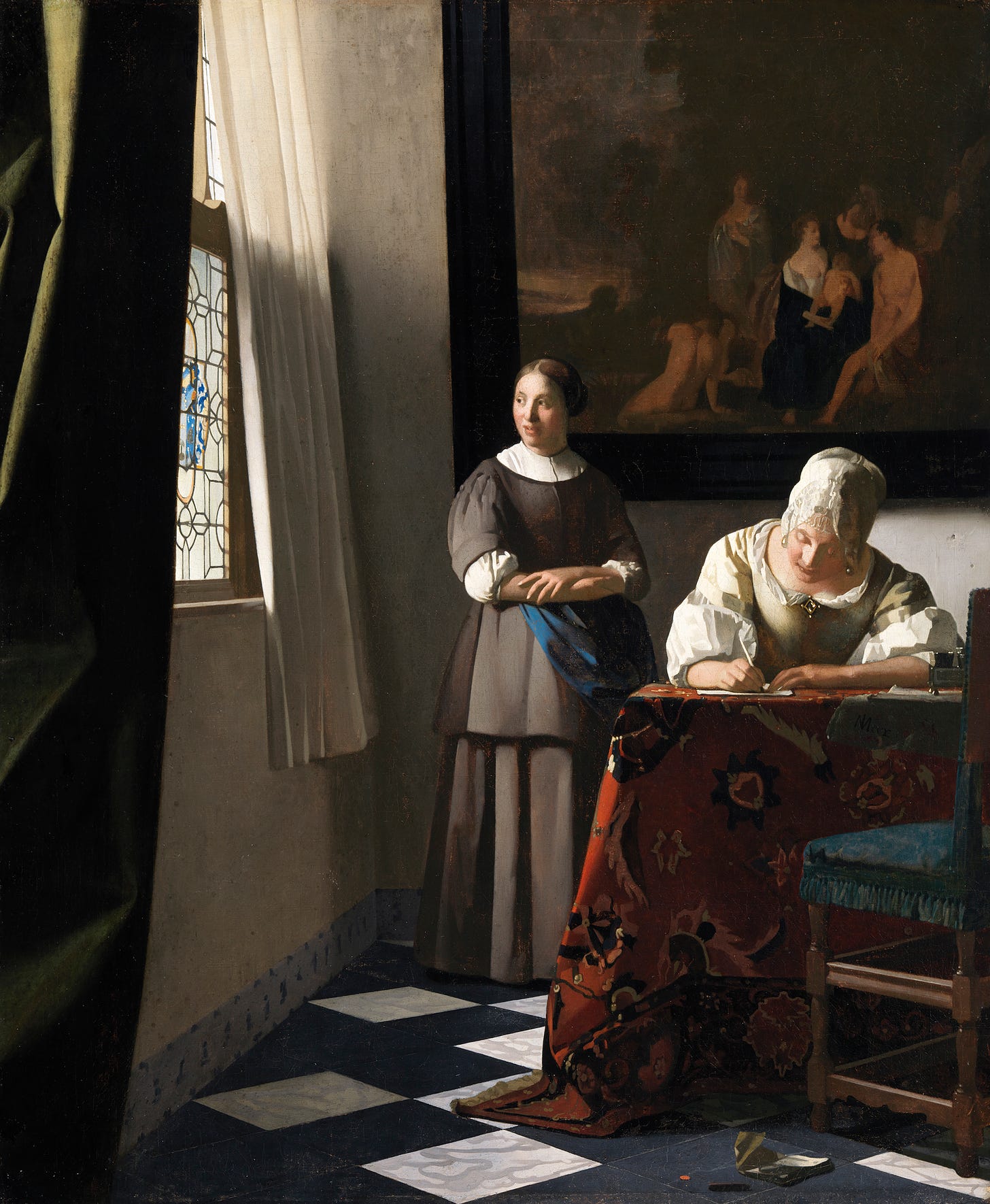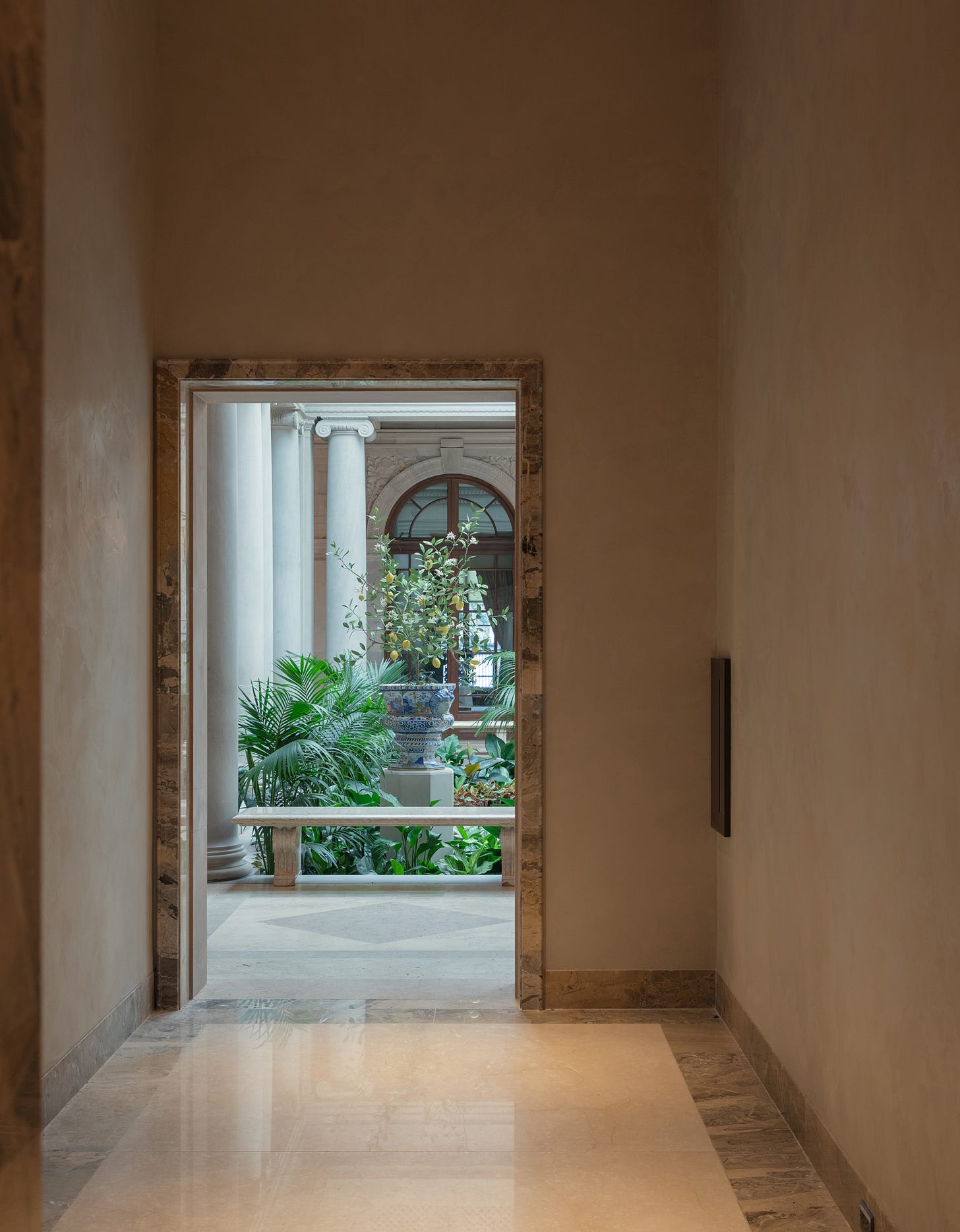Vermeer’s Love Letters Triumph at the Frick
One of the hottest new attractions in New York City
Interior, The Frick Collection, New York (Photo: (Margie Goldsmith)
Housed in an Upper East Side Gilded Age mansion, The Frick Collection finally re-opened this spring, following the museum’s first major upgrade in nearly 90 years. The exhibition has become one of the hottest attractions in NYC, with crowds lining up around the block. In addition to its world-class permanent collection and long-anticipated multi-million-dollar expansion, the Frick is currently exhibiting Vermeer’s Love Letters, a small but absolute gem of a show that, for the first time, brings together in a single gallery three masterpieces by the revered 17th century Dutch master.
Gallery View of Vermeer’s “Loves Letters” exhibition at the Frick Collection
On loan from Amsterdam’s Rijksmuseum is The Love Letter (c. 1669-70) and from the National Gallery of Ireland, Dublin is Woman Writing a Letter, with Her Maid (c. 1670-72). These two paintings flank a third larger work, Mistress and Maid (c.1664-67) which belongs to the Frick and was the last work of the art museum’s founder, Henry Clay Frick, who acquired it before his death in 1919. (Frick also owns two other iconic Vermeer paintings which are on display in the museum’s South Hall).
Johannes Vermeer( 1632-1675) is best known for his detailed scenes of everyday life. Only three dozen of his paintings exist today and of these, six explore the theme of reading, writing and exchanging letters. Clearly this subject inspired and contained rich narrative possibilities for the artist. Each of the three paintings in Vermeer’s Love Letters centers on a pair of female figures: a woman and her maidservant within a domestic space, offering visitors the opportunity to consider Vermeer’s treatment of the epistolary theme and the depiction of women of different social classes.
While the contents of the letters are not revealed to the viewer, the motif of a woman writing and sending letters would have been understood in Vermeer’s day as a coded representation of amorous exchange or courtship (with a male suitor outside the picture).
I do not consider myself an art connoisseur, so I asked my friend, Larissa Bailiff, who went with me to the show, for some guidance interpreting the paintings. Bailiff, an art historian, educator, and writer with over two decades in the field, offers entertaining and educational online 90-minute Zoom classes covering a range of topics from the old masters to modern art.
“Truly, this show can speak to anyone, regardless of your background,” says Bailiff. “It’s so great to see these three paintings in close proximity to one another, for our eyes to travel back and forth between them, and to get so close to these very detailed and intimate works. We can appreciate their scale and Vermeer’s masterful use of light and take delight in the unusual perspectives we are privy too. For instance, the Rijksmuseum’s Love Letter, in which the main scene of a maid delivering a letter to her cittern-playing mistress, is seen through a darker compositional framing which seems to position us as viewers in some type of cramped storage closet. In this way, Vermeer makes the two women’s story all the more private and mysterious.”
The Love Letter (Rijksmuseum, Amsterdam, purchased with the support of the Vereniging Rembrandt)
“Each of these paintings is a fascinating testament, filled with information, a code if you will that not only speaks to us about 17th century Dutch daily life and social conditions, but which also draws us into very human dramas that are still very alive and immediate for us today,” says Bailiff. “You don’t need to be an art historian to appreciate that. Who hasn’t burned with anticipation awaiting a letter, a call, a text from someone? On the one hand, we get a sense of what well-to-do homes in Delft looked like during the mid-17th century: the imported carved wood furnishings, the stained-glass windows, the tile work floors, and evidence of the Dutch mania for maps and art, which the middle and upper-middle classes collected and with which they covered their walls. But these objects do double time, so to speak. If you are wondering about what a 17th-century Dutch painting is trying to tell you, always observe what’s depicted on the walls; the background is meant to amplify the story.
“Behind and above the maid and mistress in Love Letter is a framed painting of a ship –not only a proud reminder that Holland built a flourishing maritime economy, but a detail included because the theme of a boat at sea was considered an allegory for the state of romantic relationships. Ask yourself, would you rather your relationship be compared to a ship on stormy sea or charting calm waters like we see here? Likewise, for contemporary audiences, the subject of the instrument would call to mind the concept of a successful, loving relationship, seen as akin to the harmony of two musicians in sync. You know the expression “to make beautiful music together…”
Mistress and Maid (The Frick Collection, NY Photo: Joseph Coscia Jr.)
“Bringing us in much closer,” says Bailiff, “The Frick’s Mistress and Maid, depicts a woman writing a letter at a table, interrupted by her maid delivering a letter to her. Conservation analysis has shown that behind the two figures there originally would have been a large green drape, likely a tapestry with some kind of narrative scene (now completely darkened and obscured by age). Undoubtedly this would have informed Vermeer’s scene, but I think we get enough of the fast and furious back-and-forth letter writing to understand the gist of the woman and her male companion’s epistolary ardor. These letters are hot of the press, as they say. Interestingly, this draped off area that the woman has made for herself within the larger interior of her home, to write letters and give herself over to her thoughts, feels wonderfully proto-Virginia Woolf’s “Room of her Own.”
Woman Writing a Letter with Her Maid (National Gallery of Ireland, Dublin:presented by Sir Alfred and Lady Beit, 1987 (Beit Collection, Photo ©National Gallery of Ireland
“I won’t go into the picture hung behind the women in the third painting loaned from Ireland,” says Bailiff. “I do, however, want to point out that I find this painting especially touching because the maid is looking out the window, giving her mistress space to write the letter. Much narrative is contained within this picture, between these two women, and of all the three works in the show, this one leads us anticipatingly outside the painting. That is to say, we follow the light through the window hitting the maid’s face, then down towards the center of the composition to the mistress, writing away, pouring her thoughts and feelings into words. They are almost one being, the two women, as the maid is the trusted important messenger, who will take this heartfelt, private message to the awaiting lover outside, and return again, continuing this special exchange. There are so many ways to interpret these works,” Bailiff adds, “but most of all, one should just come and look closely and feel them.”
Boucher Anteroom, new second-floor gallery, The Frick Collection, NY (Photo: Joseph Coscia Jr.)
The Frick’s permanent collection of 1,800 works of fine and decorative art, mostly European, span from the 14th-19th centuries. These include Old Master paintings by Bellini, Fragonard, Gainsborough, Goya, El Greco, Holbein, Rembrandt, Turner, Italian Renaissance and also early Northern European sculpture, eighteenth century European furniture, European and Chinese porcelain and carpets and more.
Henry Clay Frick (1849-1919) was an American industrialist and philanthropist who built one of the era’s more expensive private art collections. In 1913, he built a Beaux Arts-style mansion as his family residence, but he always intended for his home and collection to become accessible to the public. The original museum and adjacent building on East 71st Street housing the Frick Art Research Library and designed by architect John Russell Pope, opened in 1935. From March 2021 to 2024, the Frick underwent an extensive renovation and enhancement. During this time, the collection, rebranded as the Frick Madison, was installed a few blocks uptown on 75h St and Madison Avenue in an iconic Marcel-Breuer-designed Brutalist building from the 1960s. This was the long-term campus of the Whitney Museum before it moved to the Meat Packing District downtown. Allowing for many beloved masterpieces to remain on view, this temporary and costly solution demonstrated just how integral the original Beaux-Arts environment was to the authentic one-of-a-kind Frick experience.
Finally, the Frick is back and more cohesive and spacious than before, thanks to the thoughtful vision and execution of Selldorf Architects. The museum has added 30% more gallery space on the second floor (where the Frick family lived and was subsequently used as museum offices), new Ronald S. Lauder Exhibition Galleries on the main floor( for temporary exhibitions like Vermeer’s Love Letters), a 220-seat state-of-the-art Stephen A. Schwarzman Auditorium, and its first public café overlooking the 70th Street Garden.
The Frick has always been a special oasis in the city, but now it is sublime with a stunning skylight replacement, warm Italian marble throughout, and Murano glass pendants and wall sconces. The cozy warren of galleries on the second floor (which visitors can visit by ascending the grand staircase for the first time in the museum’s history) contain transformed rooms showcasing Italian panel painting, 19th century French landscapes, and inventively displayed decorative art objects like majolica and medallions.
View to the Garden Court, The Frick Collection, New York (Photo: Nicholas Venezia)
The refreshed and renovated main floor galleries have never looked better and are also well worth visiting. And finally, bridging the past and present as well as upstairs and downstairs, almost every room in the Frick has been enlivened with different porcelain flower arrangements, a temporary sculptural installation (on display through October 6, 2025) by contemporary artist, Vladimir Kanevsky (b. 1951). Elegant, amenable and inviting, the new Frick is a true New York City treasure, a place where one can deepen their connection to art, reencounter “old friends” (collections, objects and rooms), and make endless new discoveries.
The Vermeer exhibition, which requires a timed ticket, will only be on display through September 8, 2025, so get your ticket now.
Gallery View of Vermeer’s “Loves Letters” exhibition at the Frick Collection, New Yotk











